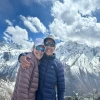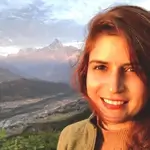Langtang Gosainkunda Trek is a spectacular journey that promises an unforgettable journey filled with natural wonders, cultural discoveries, and moments of incredible beauty, making it a must-do for outdoor enthusiasts and adventure seekers alike.
The Langtang Gosainkunda Trek is also one of the most popular spiritual treks in Nepal, especially for domestic trekkers. Gosainkunda lies in the Langtang region which is proud of having Nepal’s first Himalayan National Park also known as Langtang National Park. It offers you spectacular natural scenery, a glimpse of panoramic views of snow-capped mountains, diverse flora and fauna, and rare wild animals. Not only this, but trekkers also get the opportunity to explore the old monasteries, ethnic settlements, glaciers, and much more.
Besides other trekking regions in Nepal, the Langtang Gosainkunda trek is one of the shortest treks in Nepal. Enjoy the waterfalls, streams, hills, and mountainous views on the trekking trail of Langtang Gosainkunda! 108 lakes in the vicinity bestride at an altitude of 4,380 m in the Langtang Region, where, amongst all of them, Gosainkunda is regarded as one of the holiest lakes in Nepal. Over 25,000 Hindu and Buddhist followers visit Gosainkunda Lake on a special festival known as “Janai Purnima” which falls on the full moon of August every year. Gosainkunda Lake is well-known as the holy place to wash off the sins and pains of human beings. The interesting fact about this lake is it is frozen during the winter season (December to February). Hence, it is also popular as “the Frozen Lake of Nepal.”
EXPLORING THE ROAD TO TREKKING TRAILS OF LANGTANG GOSAINKUNDA
Located in the north of the Kathmandu Valley, for trekking in Langtang Gosainkunda, the journey starts from Kathmandu to Syabrubesi, the starting point of the Langtang Gosainkunda trek. The road journey typically takes around 7-9 hours, covering a distance of approximately 117 kilometers. The trek from Syabrubesi will begin by passing through villages like Lama Hotel, Ghoda Tabela, and Langtang Village as you ascend towards the Langtang Valley. After exploring the Langtang Valley, continue your trek towards Gosainkunda Lakes and ascend through rugged terrain, dense forests, and alpine meadows, passing by scenic viewpoints and traditional villages. Reach Gosainkunda Lakes and spend some time exploring the sacred lakes and surrounding landscapes with breathtaking views of the Himalayan peaks reflected in the crystal-clear waters of the lakes. After exploring Gosainkunda Lakes, retrace your steps back to Syabrubesi, following the same trekking route, and return to Kathmandu.
Alternatively, a circular trek can be completed by taking a different route back to Kathmandu via Helambu or Tharepati.
Spend some time in Kathmandu exploring the vibrant culture, heritage sites, and bustling streets before departing. The Langtang Gosainkunda trek provides you with one day of sightseeing around the UNESCO World Heritage Sites that lie in the Kathmandu Valley, such as Pashupatinath Temple, Bouddhanath, Swayambhunath, and more. Pashupatinath Temple is the holiest Hindu temple and lies at the bank of the Bagmati River, Patan Durbar Square is the old city of the Kathmandu Valley. Whereas Boudhanath Stupa is the world’s biggest Buddhist stupa, and Swayambhunath is popular as the Monkey Temple.
As a leading travel company in Nepal, Hiking Adventure is famous for professional, friendly tour guides with finer arrangements.
DIFFICULTY LEVEL OF LANGTANG GOSAINKUNDA TREK
The Langtang Gosainkunda Trek offers a modest degree of difficulty, attainable for those who can sustain about 6 hrs of trekking each day. While the surface is typically convenient the main difficulty hinges on adapting to the elevation. Rushing the ascent can bring about altitude sickness, so it's important to get used to it slowly as well as permit your body time to readjust to the altering altitude levels along the expedition.
To prepare for this Trek it's essential to prepare your body literally. Regular runs and walking workouts help develop endurance as well as endurance guaranteeing you remain in fine condition to deal with the trek conveniently adding strength and flexibility training to your regimen can enhance your preparedness for the trip.
Proper acclimatization techniques remaining hydrated together with climbing slowly are crucial for minimizing the risk of altitude-related concerns. Paying attention to your body and also listening to signs of altitude health issues, such as headaches or nausea is necessary for a risk-free satisfying hike.
With the ideal prep work plus technique, you'll be ready to take on the Langtang Gosainkunda Trek as well as appreciate the magnificent landscapes and also cultural experiences it has in store.
BEST SEASON FOR LANGTANG GOSAINKUNDA TREK
The Langtang Valley Expedition is best embarked on throughout the springtime and autumn seasons, offering perfect climate conditions as well as spectacular views. From March to May springtime brings light temperature levels, clear skies plus the remarkable presence of the magnificent hills. Trekkers can delight in a secure climate, making it an opportune time to check out the Langtang area without the obstacle of severe chilly or rainfall. Likewise, the autumn months of September to December deal with clear skies together with comfy temperature levels providing trekkers with optimal conditions for a memorable journey with the Mountain ranges. The landscapes are embellished with vibrant shades throughout this time around, creating a picturesque backdrop for trekking fanatics.
Nonetheless, it's crucial to stay clear of trekking throughout the winter season of January as well as February as a result of the likelihood of snowfall, which can make trail conditions challenging and dangerous. Furthermore, the rainy season from July to August poses risks of slippery paths together with landslides, interfering with the general trekking experience. By planning your Langtang Gosaikunda Trek throughout the springtime or autumn periods you can ensure a secure satisfying trip amongst the magnificent landscapes of Nepal's Mountain ranges with clear skies, secure weather conditions, and also breathtaking sights throughout your experience.
Depending on the timing of your trek, you may have the opportunity to witness colorful local festivals such as the Tamang Heritage Trail Festival or the Janai Purnima Festival, providing insights into traditional rituals and celebrations.








